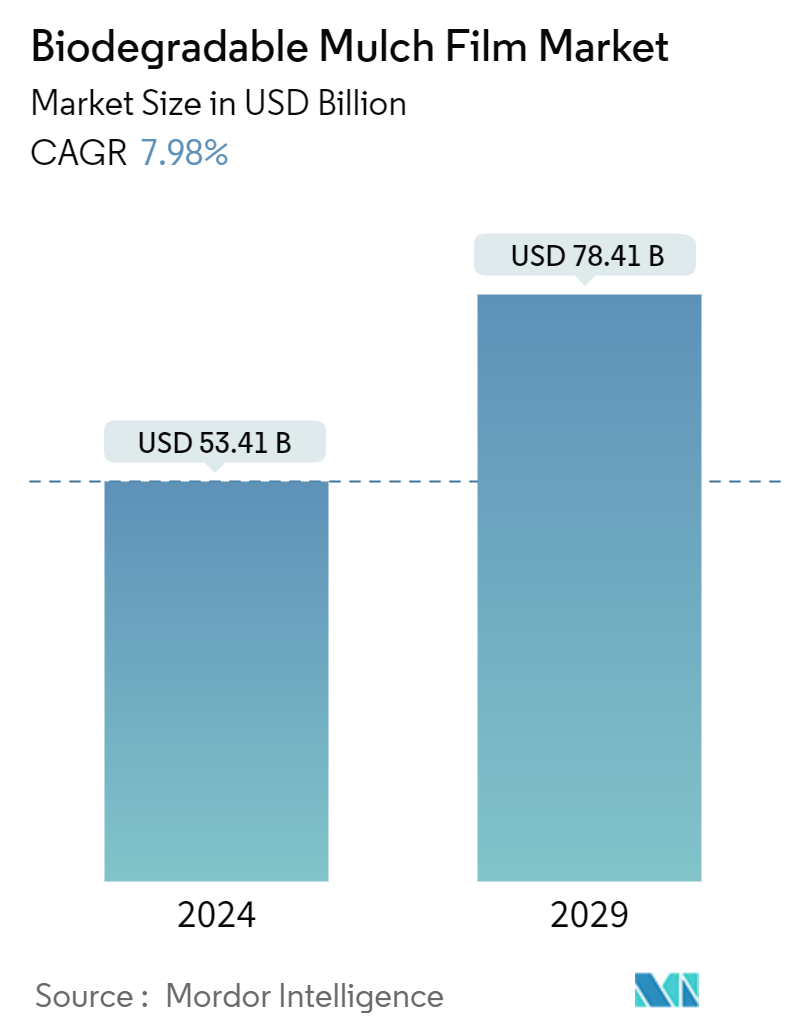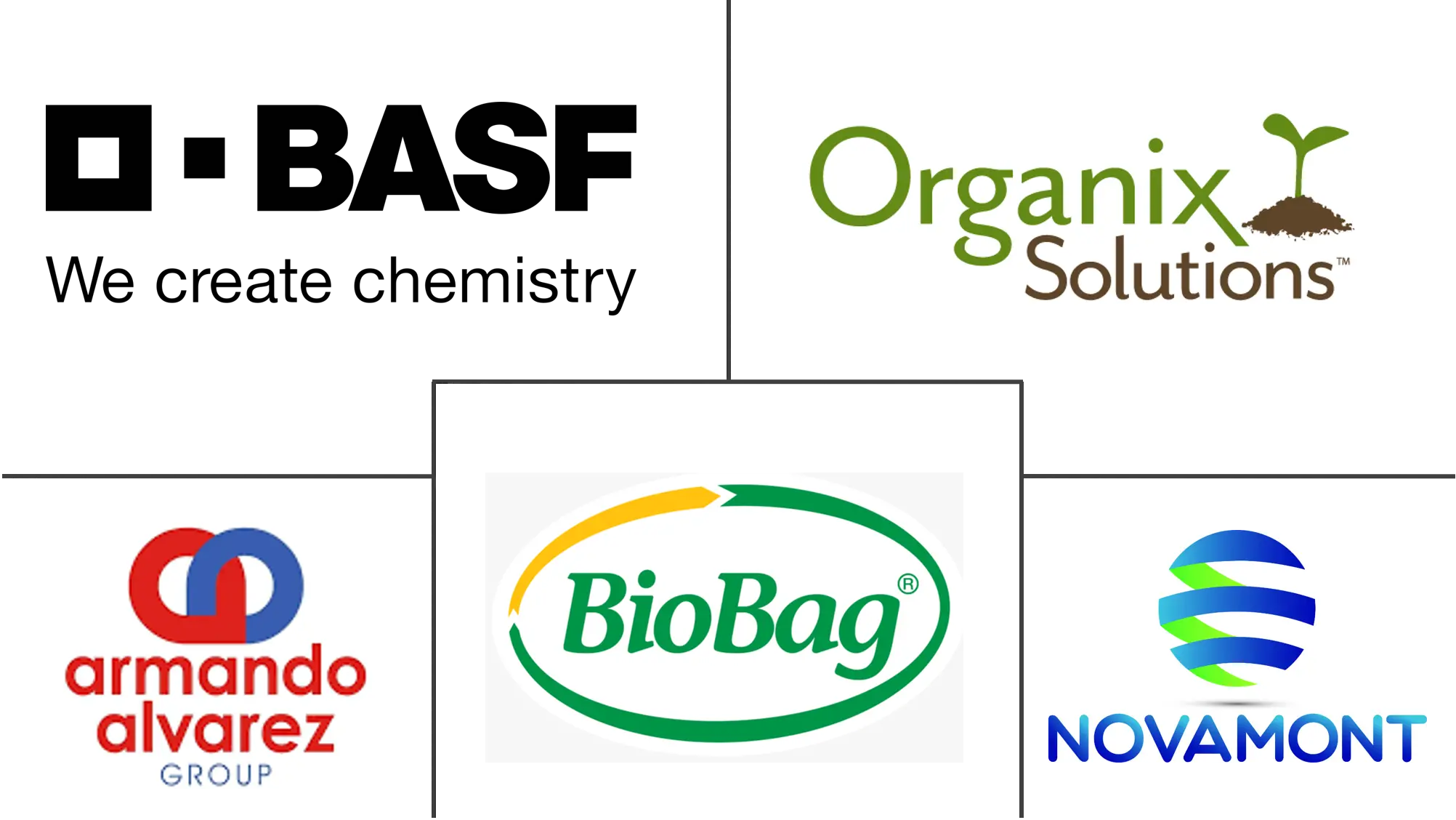Market Size of Biodegradable Mulch Film Industry

| Study Period | 2019 - 2029 |
| Market Size (2024) | USD 53.41 Billion |
| Market Size (2029) | USD 78.41 Billion |
| CAGR (2024 - 2029) | 7.98 % |
| Fastest Growing Market | Asia Pacific |
| Largest Market | North America |
Major Players
*Disclaimer: Major Players sorted in no particular order |
Biodegradable Mulch Film Market Analysis
The Biodegradable Mulch Film Market size is estimated at USD 53.41 billion in 2024, and is expected to reach USD 78.41 billion by 2029, growing at a CAGR of 7.98% during the forecast period (2024-2029).
- Biodegradability in the soil provides huge benefits for agricultural and horticultural products. Biodegradable mulching films have made rapid improvements in terms of usability, allowing cultivators to plow in bioplastic mulch after use instead of collecting them from the field for recycling, which improves operational efficiency. However, the potential environmental consequences of using biodegradable mulches have not been thoroughly studied, and international standards, such as ISO 17088, ASTM D6400, ISO 17556, and ASTM D5988, for validating their safeness are in the ongoing research phase.
- Non-biodegradable mulch films, when not properly disposed of, can lead to the loss of agricultural topsoil, with an estimated 166 kiloton/year dragged away from fields at the end of each crop cycle. In contrast, certified soil-biodegradable mulch films, with their biodegradability, not only prevent this soil loss but also play a crucial role in halting the leakage and accumulation of microplastics in agricultural soils. Additionally, these certified mulch films help curb the production of plastic waste that is notoriously challenging to recycle.
- The expansion of the greenhouse project drives the market. According to the World Greenhouse Vegetable Statistics, there are 1,228,000 acres of greenhouse growing space for production worldwide. Biodegradable plastic mulch fragments physically modify soil before they are fully biodegraded. However, PE plastic fragments reduce soil infiltration and water absorption, by which the accumulation may affect soil ecosystems in greenhouse plantations and, ultimately, result in plant germination and growth. Thus, the demand for biodegradable mulch film market increases in this segment.
- Supportive regulation from the governments for organic mulching across the world is driving the market. For instance, in Europe, EN 17033 is the new product standard made for biodegradable mulch films used in agriculture and horticulture and specifies the necessary requirements and test methods. The standard is designed for a clear reference to farmers, distributors, and stakeholders. EN 17033 is more likely to replace other pre-existing national standards in Europe.
- High installation cost, along with the addition of harmful additives during the manufacturing process, challenges the growth of the market. The deficit in the availability of such mulch films with high initial costs is challenging the growth. Moreover, the involvement of plasticizers in the manufacturing of biodegradable mulch film to make profits may challenge the market with growing awareness among the farmers.
Biodegradable Mulch Film Industry Segmentation
Biodegradable mulch films are organic mulching materials offering benefits such as weed control, maintenance of soil structure, and prevention of crops from soil contamination.
The study tracks the demand for biodegradable mulch film based on their applications in key end-user verticals. The market size and demand are represented in terms of revenue (USD). The scope of the study focuses on analyzing the revenue accrued from biodegradable Mulch Film vendors operating in the global market. The analysis is based on the market insights captured through secondary research and the primaries.
The biodegradable mulch film market is segmented by polymer (starch, polyhydroxyalkanoates [PHA], polyactic acid [PLA], and other polymers), application (fruits and vegetables, flowers and plants, and grains and oilseeds), and geography. The report offers market forecasts and size in value (USD) for all the above segments.
| By Polymer | |
| Starch | |
| Polyhydroxyalkanoates (PHA) | |
| Polylactic Acid (PLA) | |
| Other Polymers (Aliphatic-Aromatic Copolymers (AAC)) |
| By Application | |
| Fruits and Vegetables | |
| Flowers and Plants | |
| Grains and Oilseeds |
| By Geography | |||||||
| |||||||
| |||||||
| |||||||
| Rest of the World |
Biodegradable Mulch Film Market Size Summary
The biodegradable mulch film market is experiencing significant growth, driven by the increasing demand for sustainable agricultural practices. These films offer substantial benefits by enhancing operational efficiency in farming, as they can be plowed into the soil after use, eliminating the need for collection and recycling. This innovation not only improves soil health by preventing topsoil loss but also addresses environmental concerns related to microplastic accumulation. The market is further propelled by supportive government regulations and standards, such as EN 17033 in Europe, which provide clear guidelines for the use of biodegradable mulch films in agriculture and horticulture. Despite challenges like high installation costs and the presence of harmful additives, the market continues to expand, particularly in regions like Asia-Pacific, where population growth is driving increased food production.
The adoption of biodegradable mulch films is seen as a viable solution to the environmental issues posed by traditional plastic mulch films, which are difficult to recycle due to contamination with soil and vegetable residues. These biodegradable alternatives, such as BASF's Ecovio M and Novamont's Mater-Bi, offer the advantage of being directly incorporated into the soil, where they undergo natural biodegradation. This not only saves time and labor for farmers but also contributes to reducing plastic waste in agriculture. The market is characterized by a fragmented landscape with key players like BASF SE and BioBag International AS employing strategies such as new product launches and collaborations to strengthen their market presence. Recent initiatives, such as the partnership between Mondi and Cotesi, highlight the industry's shift towards sustainable solutions, aiming to replace conventional plastic mulch films with more environmentally friendly options.
Biodegradable Mulch Film Market Size - Table of Contents
-
1. MARKET DYNAMICS
-
1.1 Market Overview
-
1.2 Market Drivers
-
1.2.1 Expansion of Greenhouse Projects
-
1.2.2 Supportive Regulation from the Governments for Organic Mulching Across the World
-
-
1.3 Market Restraints
-
1.3.1 High Installation Cost and Addition of Harmful Additives in Manufacturing
-
-
1.4 Industry Value Chain Analysis
-
1.5 Industry Attractiveness - Porter's Five Forces Analysis
-
1.5.1 Threat of New Entrants
-
1.5.2 Bargaining Power of Buyers/Consumers
-
1.5.3 Bargaining Power of Suppliers
-
1.5.4 Threat of Substitute Products
-
1.5.5 Intensity of Competitive Rivalry
-
-
-
2. MARKET SEGMENTATION
-
2.1 By Polymer
-
2.1.1 Starch
-
2.1.2 Polyhydroxyalkanoates (PHA)
-
2.1.3 Polylactic Acid (PLA)
-
2.1.4 Other Polymers (Aliphatic-Aromatic Copolymers (AAC))
-
-
2.2 By Application
-
2.2.1 Fruits and Vegetables
-
2.2.2 Flowers and Plants
-
2.2.3 Grains and Oilseeds
-
-
2.3 By Geography
-
2.3.1 North America
-
2.3.1.1 United States
-
2.3.1.2 Canada
-
-
2.3.2 Europe
-
2.3.2.1 Germany
-
2.3.2.2 United Kingdom
-
2.3.2.3 France
-
2.3.2.4 Italy
-
2.3.2.5 Rest of Europe
-
-
2.3.3 Asia-Pacific
-
2.3.3.1 India
-
2.3.3.2 China
-
2.3.3.3 Japan
-
2.3.3.4 Rest of Asia-Pacific
-
-
2.3.4 Rest of the World
-
-
Biodegradable Mulch Film Market Size FAQs
How big is the Biodegradable Mulch Film Market?
The Biodegradable Mulch Film Market size is expected to reach USD 53.41 billion in 2024 and grow at a CAGR of 7.98% to reach USD 78.41 billion by 2029.
What is the current Biodegradable Mulch Film Market size?
In 2024, the Biodegradable Mulch Film Market size is expected to reach USD 53.41 billion.

